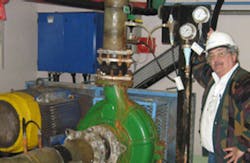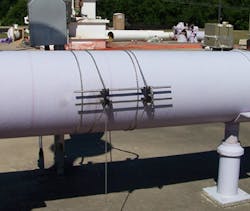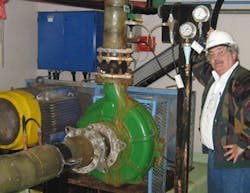(a.k.a. "The Pump Guy")
Dear Pump Guy,
I am new to the world of pumps. I recently took a position in sales with a distributor of slurry pumps. My manager assigned me to do a pump performance survey on some slurry pumps for a client. The pumps are installed at a coal mine and processing facility.
The pumps in the survey:
- Transport ambient water with coal slurry, relative density 1.8
- Have a design flow of 760-m3/hr
- Are belt driven from the motor and rotate at 550 RPM
- Have a discharge pressure range from 180-kPa to 260-kPa
I have some questions:
- Do I need to convert kPa (kilopascals of pressure on pump discharge pipe at a density of 1.8) back to meters before I plot the head on my performance curve?
- How do I do this?
- Is relative density the same as specific gravity?
- Is the pressure reading on the gauge the pressure that the pump sees?
I have the pump flow, the relative density, the RPM, a pressure gauge on each pump discharge, and the pump performance curve. I need to determine the actual duty coordinates of each pump. Please help.
Kind regards,
Walt S.
###
Hello Walt,
There is an easy way to know the duty coordinates of your pump. Let the gauges talk to you. I’ll explain.
In your message to me, you say the pumps in your survey have a discharge pressure gauge installed. You will need a suction pressure gauge to report the energy arriving into the pump. I recommend an absolute pressure gauge if possible. An absolute gauge begins at absolute zero pressure and reports vacuum in easily understood units. It is likely the liquid arrives into a pump in a slight vacuum.
The pump develops differential head or pressure. Differential pressure is the discharge pressure gauge reading minus the suction pressure gauge reading.
Next, install a slurry flowmeter onto a straight section of discharge pipe. I recommend a “clip-on” flowmeter. You can purchase a used-reconditioned flowmeter from most any instrumentation supply house and save plenty of money. You can easily move a clip-on flowmeter from one pump to the next in your survey. A clip-on flowmeter is accurate enough for a centrifugal mine slurry pump. If the application really required precise flow, the pumps would be PD pumps. The flowmeter should be mounted onto the pipe as far downstream as possible away from elbows, obstructions and other points of turbulence.
Start the pump with the performance curve handy. Allow a few seconds to let the flow stabilize. The instrumentation will tell you the head and flow duty coordinates of your pump.
You say your discharge pressures range from 180-kPa to 260-kPa. The discharge pressure rises and drops with the suction pressure. In most cases, the discharge pressure is a function of the suction pressure.
Also the discharge pressure rises and falls as the pump migrates on its performance curve. This is another reason a clip-on flowmeter is adequate for this application.
Let’s say the flowmeter reports 800-m3/hr of flow. Let’s say the discharge pressure gauge reading is 200-kPa, and the suction pressure gauge reading is 120-kPa. The differential pressure is 80-kPa (200-kPa minus 120-kPa). This is the information (converted to meters) on the pump curve.
Find the intersection of differential head and flow on the pump curve. These are the duty coordinates of your pump. With this information, you’ll know if the pump is on or off the curve. You’ll know if the pump is happy, or stressed, or vibrating, or suffering cavitation, or wasting energy, or overheating.
The gauges indicate the pump’s actual duty coordinates. The curve shows the pump’s ideal duty coordinates. If the pump is stressed, you’ll also know what to do to make the pump happy. The curve will show you how to calm the vibrations, resolve cavitation and improve the operating efficiency. There really is a lot of useful information on a pump curve.
The pump curve does not report the discharge pressure converted into meters of head. The pump curve reports the differential pressure converted into meters of head.
Many people mistakenly use the discharge gauge alone. Then they wonder why the information on the gauge doesn’t match the information on the curve, and they abandon the curve as a tool of reliability. This misunderstanding leads many reliability engineers to chase vibrations in a futile effort to determine the health of a process pump.
Now, let’s answer your questions:
First, you asked about converting pressure into head to interpret the curve. Yes! To interpret most pump curves, you need to convert kilopascals of pressure (differential pressure) back into meters of head and factor the relative density.
Here is the formula:
Where: ‘Δ’ means differential, or kPa (discharge) minus kPa (suction).
Next, you asked about relative density and specific gravity. Simply put, yes. “Relative density referenced to water” is the same as “specific gravity.” The purists and anal retentive will say the two terms have different definitions, but the result is the same.
Finally, you asked if the pressure on the gauge is the pressure that the pump sees. Basically, yes! Actually, it is the pressure that the gauge sees. For this reason, the suction and discharge pressure gauges should be mounted onto the suction and discharge flanges of the pump. If this is not possible, the gauges (or transducers) should be as close as possible to the pump nozzles.
When the gauges are mounted onto the pump flanges, the gauges report the pressure differential the pump sees. And, be aware there are pressure gradients inside the pump that vary inversely proportional to the liquid velocities inside the pump.
I hope this answers your questions. Good luck with your survey.
Regards,
The Pump Guy
Larry Bachus, founder of pump services firm Bachus Company Inc., is a regular contributor to Flow Control magazine. He is a pump consultant, lecturer, and inventor based in Nashville, Tenn. Mr. Bachus is a retired member of ASME and lectures in both English and Spanish. He can be reached at [email protected].




